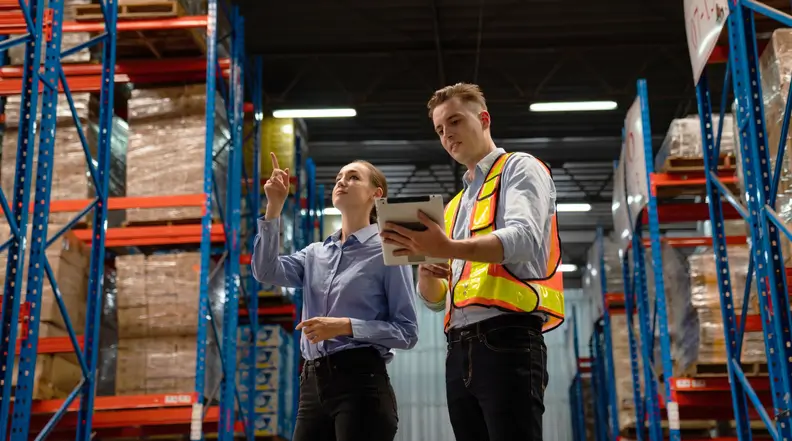Warehouses can be dangerous to work at if they are improperly maintained. Huge spaces filled with bulks of containers, heavy machinery, and whatnot, if a place lacks OSHA safety regulations, it is likely to have uncountable health hazards. According to the statistics, forklifts have accounted for nearly 100 fatalities and over 34000 serious health injuries to workers every year. Apart from this, slips, falls, and trips have also accounted for a 25% increased rate of fatalities reported in the warehouse environment. Moreover, OSHA reported that the fatality rates in warehouses are higher than in any other sector. A strong warehouse safety culture can significantly reduce accident rates, improve efficiency, and boost employee morale.
Emerging Warehouse Safety Trends in 2025
Here are some of the tech-integrated safety trends that can help you establish a safer work environment in the warehouse. Check out the most useful safety topics for warehouse meetings in 2025:
Increased Automation and Its Impact on Worker Safety
Warehouses are now being backed with technology. The rise of robotics and automated material handling systems reduces the need for manual labor but, at the same time, increases overall efficiency. These bots tend to make no human error or mishandling of heavy objects/containers. Collaborative robots are making waves in the warehousing industry. These cobots are integrated to work alongside employees, requiring new safety protocols to prevent collisions and injuries. Additionally, AGV – Automated guided vehicles help minimize human involvement in high-risk tasks. To take a seamless look into machine maintenance and have real-time monitoring of malfunctions, warehouses have integrated AI and cybersecurity software.
The Role of AI and IoT in Hazard Detection and Accident Prevention
Whether it’s the Internet of Things (IoT) or AI, these tech revolutions are making warehousing safe and secure. AI-driven safety monitoring systems help detect potential hazards in real time like improper forklifting. IoT wearables provide real-time alerts of worker’s health. AI-powered sensors and cameras ensure that the vicinity stays monitored based on OSHA regulations and policies. Lastly, Predictive analytics powered by AI helps companies identify high-risk areas and implement preventive measures before accidents occur. AI has become one of the most important safety topics for warehouses through its comprehensive approach to maintaining safety.
OSHA’s New Safety Regulations For 2025
Occupational Safety and Health Administration (OSHA) introduces yearly policies and regulations for industries based on their workflow and environment. In 2025, OSHA will have much stricter policies where the organizations are focusing on emerging risks associated with automation and advanced technologies in warehouses. Organizations are advised to have more appropriate PPE, including wearables and other high-tech safety gear, to minimize risks.
Key Warehouse Safety Topics for 2025
Warehousing falls under the general industry standards of OSHA. The policies pertaining to general industry are applicable in all warehouses. According to this HazCom program is of prime importance. Warehouse operators should create proper Hazard Communication policies to guide all workers who are prone to encounter hazards. Secondly, there should be an emergency action plan in place.
Workers must be aware of the emergency evacuation drill and all possible hazards. Thirdly, fire safety plans are a must to follow. Warehouse managers must give proper training to all workers about fire safety drills. Lastly, according to OSHA, it’s important to keep working/walking surfaces fully maintained. This helps reduce slips, falls, and trips.
Here are key warehouse safety topics for meetings you need to be aware of and know how to control.
-
Forklift & Heavy Equipment Safety
Forklift accidents are one of the most important hazards in a warehouse and to ensure a new safety plan, organizations are using AI-powered forklift monitoring systems. Moreover, employers are reinforcing forklift operator training to ensure compliance with OSHA’s Powered Industrial Truck standards.
-
Slips, Trips, and Falls Prevention
The Bureau of Labor Statistics (BLS) has reported that slips, trips, and falls account for 25% of all warehouse injuries. Hence, to combat the problem, OSHA instructs for enhanced floor safety protocols to follow that include anti-slip coatings and real-time hazard detection sensors.
-
Ergonomics and Injury Prevention
Warehouses are introducing wearable exoskeletons as Musculoskeletal disorders (MSDs) account for 33% of workplace injuries. Combatting MSD has become one of the most important safety concerns in 2025. Height-adjustable workstations and AI-driven lifting assistance help minimize repetitive motion injuries.
-
Warehouse Fire Prevention and Emergency Preparedness
Some of the key hazards in warehouses include electrical malfunctions, faulty equipment, and flammable materials. It’s important to follow OSHA’s new fire safety compliance rules that emphasize fire-resistant storage solutions.
-
Hazardous Material Handling and Chemical Safety
To prevent harmful chemical exposure-related illnesses, it’s important to have automated spill detection sensors. Through smart ventilation systems and prompt use of technology, it’s easier to neutralize chemical hazards quickly.
Wrap Up
Identifying hazards and complying with safety regulations put forward by OSHA can help build a safe working place. Warehouses are huge spaces with fewer employees. There have been several incidents and injuries due to negligence of safety protocols. It’s important to have proper OSHA regulations in place.

